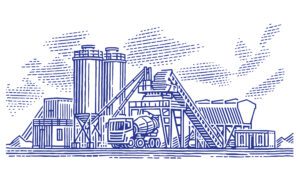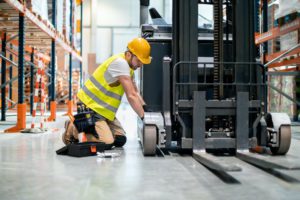4 Ways to Maximize Worker Safety in Industrial Operations
No one can argue that worker safety should be the No. 1 priority, especially at plants and factories where workers handle dangerous materials and equipment. Yet according to the U.S. Bureau of Labor Statistics, fatal on-the-job injuries increased 2% in the U.S. between 2017 and 2018 (the latest figure available), from 5,147 to 5,250.
Any accident, is one too many. Safety incidents – catastrophic or not – not only impact employees, but also customers, brand perception and the bottom line. Even near-miss events where accidents could’ve happened but didn’t must be dealt with seriously and proactively, because they still indicate a real potential for an incident to actually occur and puts worker safety in question.
Additionally, work performed by human workers and machines are becoming more connected and driven by data insights, adding a new layer of urgency to reassess and update safety management approaches and initiatives.
For plant and operations managers, creating an environment where safety is always prioritized is necessary, but may seem formidable at a time of such accelerated change. Here are four actionable ways to maximize worker safety and ensure it’s top of mind in every corner of the plant.
1. Provide ongoing, on-the-job worker safety training
Operators and technicians – new and veteran – should have access to mandatory, up-to-date safety training, especially as new equipment, updates to existing equipment, and safety-related changes to standard operating procedures (SOPs) are introduced.
For decades, this type of training was typically done in a classroom setting, off the production floor, a few times a year. But, that’s no longer effective in today’s increasingly digital factory.
Rather, safety training is most effective when it’s done on the job, integrated into the work execution and SOPs themselves instead of separate instruction.
Technology that digitizes SOPs, and inserts safety requirements to be met before a worker can move forward to the next task in the procedure, is an essential step toward ongoing, consistent on-the-job safety training (but certainly not the only thing).
Positive safety behavior is reinforced on a continuous basis, ultimately resulting in a proactive safety management system across operations.
(Read more: How Connected Work Improves Safety Management in Industrial Environments)
2. Make it easier to promptly report incidents to EHS teams
Many industrial safety incidents, especially minor ones, are poorly recorded and/or reported well after the event has occurred. This is far from ideal, for many reasons.
Descriptions based on a worker’s fading memory of what took place leading up to, during and after a safety incident can be unreliable and potentially inaccurate. The ability to potentially correlate the incident to other recorded factors happening on the floor – like an error code thrown by a sensor on a machine down the line – becomes more difficult. The likelihood of treating the incident as an outlier increases.
By offering frontline workers the ability to report in real-time more accurate information and data around hazards, safety incidents, and near misses as they occur, plant and EHS managers can more easily identify areas and trends where high-priority analysis needs to take place. This can be accomplished by technology solutions that can capture on-site evidence and information in various formats. Technology also can make it easier for workers to notify and communicate with safety teams promptly through texts, alerts and status updates.
3. Conduct consistent, actionable JSAs
Performing regular job safety analysis (JSAs) to define and control hazards associated with a specific job are essential to good safety management. Updating them on a regular basis and providing employees with easy access to their findings are also critical to generating greater awareness of safety risks.
The problem with most JSAs is that they’re usually paper-based and, while the examination and documentation of every step within the job being analyzed is systematic, the answers are often open-ended and prone to individual interpretation. This often leads to findings that are inconsistent with little standardization of the observations made and, as a result, largely unactionable.
New modern digital tools can help standardize the JSA process, as well as improve the way findings and action items are communicated and enforced to affected workers.
By transforming JSAs into digital, interactive formats with clear parameters for observations and inputs, both operations and EHS management can get a more consistent, accurate picture of hazards on the floor and how to reduce them.
Additionally, technology now offers the ability for managers and supervisors to make changes and updates to the job’s digital SOPs in real-time based on data collected from JSAs – a major improvement to the old way of pinning a notice on a bulletin board.
4. Develop and propagate preventative safety measures
The hierarchy of controls is a well-known tool for developing preventive measures for hazards associated with job tasks. The National Institute for Occupational Safety and Health (NIOSH) lists the five controls as:
- Elimination – Physically remove the hazard
- Substitution – Replace the hazard
- Engineering controls – Isolate people from the hazard
- Administration controls – Change the way people work
- PPE – Protect the worker with personal protective equipment
Elimination is considered to be the most effective, longest-term solution to improving job safety, but is difficult and expensive to implement. Administrative controls and PPE measures are easier but often difficult to sustain in the long term, because – let’s face it – habits and behavior are hard to change.
New technology that embeds steps for hazard control within digital SOPs themselves can dramatically help with the challenge of getting even the most veteran workers to adopt new ways of executing their jobs, including ensuring the proper PPE is in place. With digital SOPs, workers can be required to put on the appropriate PPE – and even take a photo to prove they’ve done so – before they can advance to the next step of the procedure.
Conclusion
With these four areas checked off, EHS and operations managers are well on their way to building a truly connected work production environment. And with it, a culture emerges where safety best practices 1) are properly followed and with consistency, 2) can be dynamically updated across the plant – and even the entire organization – when there is a better, safer way to execute a job, and 3) can come from frontline workers themselves, who are empowered with connected worker technology that supports real-time collaboration and communication.
Download our new eBook, “How Connected Work Improves Safety Management in Industrial Environments,” to learn more about how connected worker technologies can increase safety for workers, customers and the whole business.






